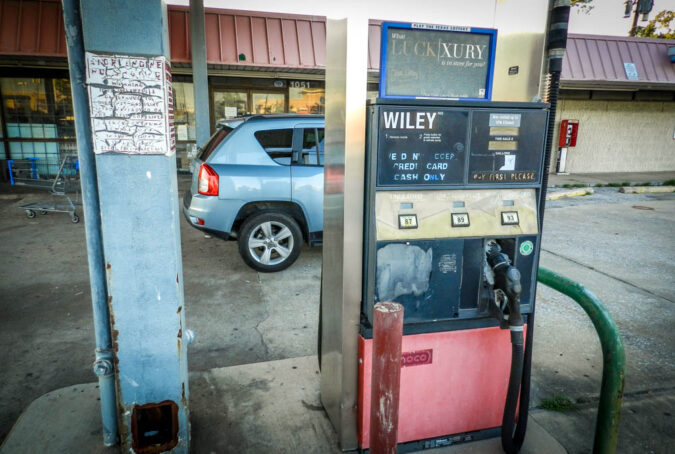The P0463 code corresponds to your vehicle’s fuel level sensor. When the gasoline level sensor output is too high, one of your car’s computers (usually the powertrain control module or PCM) will activate the code. Because it is a generic code, it can be used on many other makes and models.
The “Fuel Level Sensor Circuit High Input” OBD II fault code P0463 indicates that your vehicle’s fuel sensor is sending an excessively high voltage signal. The PCM or BCM has no idea of verifying how much fuel is in the tank; the controller only has data regarding the fuel level that comes from the sender unit’s signal voltage.
As a result, irrespective of whether the tank is full or empty, the controller anticipates observing a specified signal voltage that matches that state, which means that if, for example, when a short circuit (or any other problem) causes a resistance that is incompatible with either condition, code P0463 is triggered, and a warning light is activated.
- What is the P0463 Code?
- What are the Causes?
- Symptoms of P0463 Code?
- Fuel Level Sensor Work
- Step to Diagnose
- What are the Solutions?
- Common Errors
- Tips to Avoid P0463
- Fix P0463 Code
P0463 Code
Your vehicle’s computer uses the fuel level sensor in your engine to determine how much fuel is left in the tank. The powertrain control module (PCM) or engine control module (ECM) receives this information and changes the sign on the dashboard accordingly.
A float attached to an arm serves as the fuel level sensor’s functional component. The tank or a special circuit is used to ground this arm. The voltage varies as the resistance to the ground changes as it rises or lowers, signaling a change in fuel level.
The gasoline level sensor is often integrated directly into the fuel pump. There are exceptions, but you can’t normally repair one without replacing the other. The voltage of your fuel level sensor differs depending on the make and model. It usually functions at 5 volts. The voltage for your vehicle can be found in your owner’s manual.
When the fuel level sensor alerts the ECM or PCM that the tank is full, the P0463 code is set. The voltage must generally be higher above the threshold for a specified amount of time before the code can be activated.
Causes Of The P0463 Code
When diagnosing P0463, a frequent mistake is to change the fuel pump when the problem is with the fuel level sensor or to replace the fuel level sensor when the problem is with the wiring.
1. Sensor For Fuel Level
A malfunctioning fuel level sensor is one of the most prevalent causes of P0463 in your diagnostic codes.
2. Issue Of Wiring
Over time, the wiring to and from the gasoline pump can corrode. A faulty signal to the fuel gauge and the powertrain control module can be caused by a shorted or broken wiring harness.
You’ll need to look for a short in the wire harness. Because the harness is located beneath the vehicle and is separated from the computer by a significant distance, it has the potential to short out or become damaged.
3. Float
A float indicates how much fuel is remaining in your gas tank. It is buoyant and floats above the fuel. It sends a signal to the fuel gauge as it depletes, indicating how much fuel remains in the tank. You’ll receive P0463 and the check engine light if something bad happens with it.
4. Fuel Tank
The P0463 code might be caused by the gas tank becoming overly corroded or broken.
Other Factors
- The fuel level sensor isn’t working properly.
- A faulty or malfunctioning fuel level sensor float, leading to incorrect fuel measurements.
- Fuel level pump that isn’t working — A fuel level sensor is included in some car models as part of the fuel pump.
- The fuel level sensor circuit is either open or short.
- Either the ground is completely open or has a large amount of resistance.
- The fuel tank had been damaged.
- Corrosion has caused the gasoline tank to deteriorate.
- PCM failure
P0463 Code Symptoms
Code P0463 has a number of symptoms, but the following are the most notable:
- The “Check Engine” light will blink on the dashboard whenever Code P0463 is triggered.
- The “Low Fuel” light – The fuel light on the dashboard will frequently blink as erroneous data from the fuel level sensor reaches the PCM.
- Fuel gauge readings that vary and are incorrect — Erroneous information, such as full and empty gas tank readings, might be displayed by a defective fuel level sensor.
Fuel Level Sensor
The fuel level sensor has traditionally been a device situated inside the fuel tank with a resistive strip and a wiper contact that glides on that strip. The wiper contact is attached to a long, single-piece metal arm (lever) with a fixed axis on which it hinges, allowing the arm to move the contacts along the resistive strip as it moves up and down.
The metal arm’s longer side is several inches in length, with a brass or foam plastic float at the end to keep it on top of the fuel in the tank. As the gasoline level rises or falls, the arm swings up and down, causing the contacts on the opposite side of the axis to move in response, thus changing its resistance to communicate the fuel level.
The wiper contacts are normally connected to a wire that leads back to the fuel gauge’s coils, which are provided with electricity, and the voltage travels through the coils and through the wire harness to the wiper contacts. The ground route causes the coils in the fuel gauge to become magnetized, driving the needle toward empty as the wiper goes closer to the ground.
The gasoline gauge will read past full if the fuel sending unit strip loses its ground, the contacts wear out to the point that they no longer touch the strip, or the wire from the touchpoints to the gauge is cut, chewed, or damaged. The gauge will read empty if the wire connecting the contacts to the earth is shorted to the ground.
Fuel Level Sensor A Circuit High
Although electronic instrument clusters existed prior to OBD2, fuel level sensor data was still supplied directly from the fuel tank sender. However, as OBD2 became more prevalent in the mid-to-late 1990s, the ECM/PCM required to know the gasoline level for emissions reasons, and some makers’ platforms’ EVAP systems wouldn’t run EVAP tests unless the fuel level was between 15% and 85%.
As time passed, body computers (also known as ECM/PCM) became the module that monitored fuel levels and sent that data to the instrument cluster and ECM/PCM. However, the sending unit requires voltage to function.
The ECM/PCM will identify a failure by a voltage reading that is outside of an appropriate window if the sending unit circuit is broken (cut wire, lost ground, etc.) or if the sending unit has failed. When this type of failure occurs, the computers fail to update the fuel level, causing the fuel gauge to indicate something other than empty or full, even if the reading isn’t correct.
Steps To Diagnose P0463 Code
A malfunctioning gasoline level sensor, faulty cabling, or a damaged fuel tank are all possible causes of engine code P0463. Follow the steps below for the correct diagnosis if you want to try to fix problem P0463 at home without spending money on parts. Connect your favorite OBD2 scan tool to see if there are any extra codes in the system.
Step 1: Check for any other Engine Codes with an OBD 2 Scan Tool.
Scan your vehicle using an OBD2 scan tool to ensure P0463 is the only code present.
Step 2: Examine the Fuel Level Readings.
Check your gasoline level against the fuel gauge on your dashboard to verify if they’re the same. Examine whether you have more or less fuel than either of these indicators suggest. A live data reading of your fuel level is not available in all vehicles. If not, fix any wire that has an open or short circuit.
Step 3: Check the Level of Fuel and add more if necessary.
Fill up your car with a few gallons of gas. After fueling, check the fuel gauge and the OBD data to ensure an accurate fuel reading. You may require a new instrument cluster if your OBD 2 readings are correct but your dashboard fuel gauge is erroneous.
Step 4: Examine the Wiring.
Visually inspect the wiring around the fuel level sensor and the wiring harness around it for fraying or disconnections.
Step 5: Replace the Fuel Level Sensor or the Fuel Pump.
If the problem persists, replace the gasoline level sensor or the entire fuel pump unit if the sensor is built into it, depending on your automobile.
Possible Solutions
Fuel pump sensors are designed to withstand the lifetime of the fuel pump. As a result, if this code appears, visually inspect the gas tank and electrical harness. Examine the tank for any signs of damage, which could suggest a shock that caused the gasoline pump or sensor to fail.
Missing Grounding Strap
Look for a missing grounding strap or a rusty grounding at the region where the gasoline tank is connected to the frame.
Harness Connector
Examine the harness connector for any signs of wear and tear. If required, make repairs. Determine which system you have and ensure that the fuel level sensor in the fuel pump harness is powered on.
Voltage Drop
A voltage drop test on the ground circuit can reveal whether or not the ground circuit has a high resistance route. Using a voltmeter, connect one wire to the battery’s ground terminal and the other to the gasoline level sensor’s ground on the tank. Start the car (preferably the engine is running). It should not exceed 100 millivolts (1 volt).
A reading near 1 volt suggests a persistent or developing issue. If the ground of the fuel level sensor has to be fixed or cleaned, do so. The instrument cluster could have failed internally or on the printed circuit board (if applicable).
Non-professionals have a hard time putting them to the test. You can disconnect the instrument cluster and investigate the broken circuit if it is on the PCB if you know the electrical schematic; otherwise, you’ll need a scanning tool that can interface with the instrument cluster.
Fuel Level Sensor
Check that the fuel level sensor is correctly grounded at the fuel tank connector to verify the fuel level circuit. It must go to one extreme or the other with a key on the gasoline gauge. If the grounding path is completely removed, the pressure gauge should behave in the other direction.
If the sensor is activated, the cabling that delivers voltage and ground to the fuel sensor is fine, and the instrument cluster is most likely in proper working order. It’s most likely that the fuel level sensor is at blame. The fuel tank may need to be replaced in order to obtain access to the gasoline pump module. Failure of the PCM or BCM (Body control module) is not uncommon, however, it is rare. In the first place, you didn’t suspect anything.
Common Errors In P0463 Code Diagnosis
- Some of the most common errors and misdiagnoses with a P0463 code, according to technicians, are:
- When the problem is basically a damaged or malfunctioning fuel gauge or fuel level sensor, the fuel pump is replaced.
- Before evaluating wire and connectors for defects or shorts, replace larger, more expensive parts.
- The fuel gauge must be replaced when the problem is a rusted or otherwise defective wire or connector.
Tips To Avoid P0463 In The Future
A damaged fuel tank or damaged wiring around the fuel level sensor is the most common cause of the P0463 fault code. You can’t do much to keep your tank from being damaged from the outside, but you can minimize interior wiring issues.
Anti-corrosion treatments can help preserve the wiring in your engine from a variety of issues. Engine components should also be installed with precaution. Check that each wire is properly fastened and that none of the wires are rubbing against sections of your engine that could cause significant damage.
How Serious Is The P0463 Code?
This code does not pose a direct threat to the car, but it can put you in a potentially dangerous or inconvenient scenario. If you don’t know how much fuel your vehicle has, you risk running out when you’re far away from home or in terrible weather. The scenario could be extremely dangerous if your vehicle stalls in traffic due to a lack of fuel.
How To Repair P0463 Code?
The following are some of the most prevalent P0463 fixes:
- The fuel tank has to be repaired or replaced.
- The fuel level sensor float has to be repaired or replaced.
- The fuel level sensor has to be repaired or replaced.
- The fuel level sensor’s wire harness has to be replaced.
- The fuel level sensor circuit has a loose connection that is being tightened.
How To Fix P0463 Code
The procedure for diagnosing and repairing Code P0463 is simple and uncomplicated. However, some aspects of the process require extra attention in order to keep the expense of repairs and replacements to a minimum.
To diagnose the vehicle and locate the problem, you can use an OBD2 scanner like BlueDriver or FIXD, as well as the associated mobile app.
The following are the actions you or a repair specialist must take:
- Connect your favorite OBD2 scan tool to discover whether the system has any other codes. Clear the check engine light and the Code P0463 from the system with the device.
- To find the problem, look through the freeze frame data and the fuel gauge. Keep an eye out for gasoline levels that are either too low or too high.
- Fill the tank with more gasoline to check the fuel gauge reading. Examine the fuel gauge to determine if the gasoline level was accurately indicated after the addition.
- A common mistake is to stop the diagnostics and start repairs before analyzing the wiring and connections around the fuel level sensor and harness. It’s possible that the sensor is in fine working order, with the problem arising from the wiring.
- If the Code P0463 persists after all of the inspections and repairs, it may be necessary to replace the fuel level sensor. Or, in certain cases, the entire fuel pump.
How Much Does It Cost To Fix P0463 Code?
P0463 might be caused by a faulty gasoline level sensor, poor wiring, or a damaged fuel tank. It’s impossible to give an accurate estimate without first examining the problem thoroughly.
If you bring your automobile in for a diagnosis, most shops will start with an hour of “diag time”. This is the time spent in labor diagnosing your specific issue.
This can cost anywhere from $75 to $150, depending on the shop’s labor rate. If you have the shop execute the repairs for you, many, if not all, of the businesses will apply the diagnostic cost to any required repairs. After that, a company will be able to present you with an accurate P0463 code repair quote.
Possible Repair Costs For P0463
The underlying issue for error code P0463 may necessitate one or more of the following remedies. The cost of the needed parts as well as the cost of labor required to accomplish the repair are included in the estimated cost of repair for each potential repair.
- Fuel level sensor costs between $864 and $1,023
- Pump prices range from $806 to $967.
- Instrument cluster cost is: $804 to $824
P0463 Code Facts: Fuel Level Sensor Circuit High Input
- The P0463 code is a Diagnostic Trouble Code (DTC) that indicates the powertrain control module (PCM) has received a high input signal from the fuel gauge or fuel level sensor that is higher than the actual fuel level in the gas tank.
- The PCM determines the fuel level in the tank through low-voltage input signals and any voltage reading outside the normal range will result in a P0463 code.
- The most common causes for the P0463 code include problems with the fuel level sensor circuit, a faulty fuel level sensor, damage to the fuel level sensor float in the gas tank, damage or corrosion in the gas tank, or a problem with the PCM (rare).
- Symptoms of the P0463 code include illumination of the Check Engine Light, a fluctuating or inaccurate fuel gauge, the illumination of the Fuel Light, and/or sounding of the alarm for low fuel.
- Mechanics diagnose the P0463 code by first checking the code and any other codes that have been stored using an OBD-II scanner and then attempting to duplicate the circumstances under which the code was first recorded.
- Common mistakes when diagnosing the P0463 code include replacing the fuel pump when the problem is actually a damaged or faulty fuel gauge or fuel level sensor, replacing larger, more expensive components before inspecting wiring and connectors for faults or shorts, and replacing the fuel gauge when the problem is a corroded or otherwise damaged wire or connector.
- The P0463 code is not an immediate danger to the vehicle, but it can put you in a dangerous or inconvenient situation, such as running out of gas when you’re far from home or in poor conditions or stalling due to lack of fuel in traffic.
- Repairs that can fix the P0463 code include repairing or replacing the fuel tank, repairing or replacing the fuel level sensor float, repairing or replacing the fuel level sensor, replacing the wiring harness for the fuel level sensor, or tightening a loose connection in the fuel level sensor circuit.
- It’s important to get the P0463 code resolved as soon as possible, especially if you need to get an OBD-II emissions test to renew your vehicle’s registration in your state, as the PCM will keep the Check Engine Light illuminated until the problem is resolved, and you cannot pass an emissions test.
- Fortunately, the problem is usually easily fixed without great cost.
FAQs
Here are some popular FAQs:
What Is P0463
When your vehicle’s powertrain control module (PCM) detects erroneous fuel level readings from the fuel level sensor, the P0463 code is set. The fuel level sensor informs the PCM of the amount of fuel in the fuel tank. The check engine light is on as a result of this code because the fuel level sensor indicates that there is more fuel in the tank than the tank can properly hold.
What Are The Symptoms Of Code P0463
The symptoms of code P0463 often include the following, in addition to a stored issue code and an illuminated warning light… It’s possible that the gasoline level reported isn’t the same as the actual level. The low fuel level warning light may flash or remain on permanently even if there is enough gas in the tank to prevent triggering the low fuel level alarm. Besides that, the engine may shut down or fail to start due to a lack of fuel, even if the fuel gauge readings are above Empty. In addition, when the self-diagnostic system is unable to register an exact fuel level, it may display EVAP System Not Ready alerts.
What Are The Causes Of Code P0463
The most prevalent reasons for code P0463 are the same in all products, and they are the wiring and/or connectors that have been burned, damaged, shorted, or corroded. Additionally, the circuits are not closed or if the ground is gone. Aside from that, the gasoline level sender device is broken. Otherwise, the gasoline tank has been damaged, preventing the moveable arm from moving freely. It’s worth noting that not all programs will set the code if the gasoline tank is damaged. Alternatively, your PCM/BCM isn’t working properly. It’s worth noting that this is a rare occurrence, and the problem must be found before any controller is replaced.
What Is The Cost To Diagnose The P0463
1.0 hours of labor is required to diagnose the P0463 code. The diagnosis time and labor rates for auto repairs vary by region, vehicle make and model, and even engine type. The average hourly rate in an auto repair shop is $75 to $150.
How To Correct P0463 Fuel Level Sensor Circuit High Input
We’re here to help you determine the best approach for repairing the problem after you’ve learned about the symptoms and a few common causes of the OBD error code. You must take certain steps to repair any issue and to resolve OBD error code P0463. You must replace the fuel tank, which may need to be repaired or replaced. Furthermore, the fuel level sensor float can be restored or changed. Or, the fuel level sensor must be replaced or restored. Other than that, you’ll have to change the wire junctions of the fuel level sensor. If the gasoline level sensor circuit has any weak connections, tighten them.
What Does Code P0463 Mean
In the gasoline level sensor unit, the fuel level sensor is placed. The sensor detects the presence of fuel in the tank and sends a signal to the Engine Control Module (ECM). The mechanical float is one-half of the fuel level sensor, while the variable resistor is the other. The fuel level sensor output voltage fluctuates depending on the movement of the gasoline mechanical float.
Final Verdict – P0463
P0463 is a fault code that can be found on a diagnostic scan of your engine control unit. This error code is caused by “Fuel level sensor circuit high input.” This indicates that the amount of fuel detected in your fuel tank is greater than the tank’s capacity. Because you can’t have more fuel in your tank than it can physically hold, something must be wrong with your sensor or some other equivalent component.
This problem could be caused by corroded wires, damaged wires, shorted wires, a cracked gasoline tank, a faulty fuel level sender unit, open circuits, or a dysfunctional engine control unit. In the vast majority of cases, the issue is related to your wires or circuits. You shouldn’t have any problems with your gasoline tank or engine control unit unless you’ve recently been in an accident.




